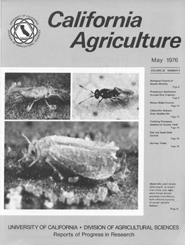


University of California
California Agriculture
|
|||
|
|||

Cover:
Above left, adult female Cales noaki, an import from Chile, and, right, adult female Amitus spiniferus from Mexico, both effective parasites of wooly whitefly (below).
May 1976
Volume 30, Number 5 |
|||
|
University of California, 1301 S. 46th St., Bldg. 478 Richmond, CA
|